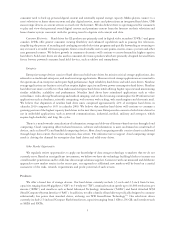Western Digital 2011 Annual Report Download - page 21
Download and view the complete annual report
Please find page 21 of the 2011 Western Digital annual report below. You can navigate through the pages in the report by either clicking on the pages listed below, or by using the keyword search tool below to find specific information within the annual report.continued uncertainty and volatility in global economic conditions, however, we may find it increasingly
difficult to be able to insure these accounts receivable. We could suffer significant losses if a customer whose
accounts receivable we have not insured, or have underinsured, fails and is unable to pay us. Additionally,
negative or uncertain global economic conditions increase the risk that if a customer whose accounts receivable we
have insured fails, the financial condition of the insurance carrier for such customer account may have also
deteriorated such that it cannot cover our loss. A significant loss of an accounts receivable that we cannot recover
through credit insurance would have a negative impact on our financial results.
•Impairment Charges. Negative or uncertain global economic conditions could result in circumstances, such as a
sustained decline in our stock price and market capitalization or a decrease in our forecasted cash flows such that
they are insufficient, indicating that the carrying value of our long-lived assets or goodwill may be impaired. If
we are required to record a significant charge to earnings in our consolidated financial statements because an
impairment of our long-lived assets or goodwill is determined, our results of operations will be adversely affected.
We participate in a highly competitive industry that is subject to the risk of declining average selling prices (“ASPs”), volatile
gross margins and significant shifts in market share, all of which could adversely affect our operating results.
Demand for our hard drives depends in large part on the demand for systems manufactured by our customers and on
storage upgrades to existing systems. The demand for systems has been volatile in the past and often has had an
exaggerated effect on the demand for hard drives in any given period. As a result, the hard drive market has experienced
periods of excess capacity, which can lead to liquidation of excess inventories and more intense price competition. If more
intense price competition occurs, we may be forced to lower prices sooner and more than expected, which could result in
lower ASPs, revenue and gross margins. Our ASPs and gross margins also tend to decline when there is a shift in the mix
of product sales, and sales of lower priced products increase relative to those of higher priced products. In addition, rapid
technological changes often reduce the volume and profitability of sales of existing products and increase the risk of
inventory obsolescence. These factors, along with others, may result in significant shifts in market share among the
industry’s major participants.
Our failure to accurately forecast market and customer demand for our products, or to quickly adjust to forecast changes, could
adversely affect our business and financial results or operating efficiencies.
The data storage industry faces difficulties in accurately forecasting market and customer demand for its products.
The variety and volume of products we manufacture is based in part on these forecasts. Accurately forecasting demand has
become increasingly difficult for us, our customers and our suppliers in light of the volatility in global economic
conditions and a recent shift from air to ocean freight in response to increased transportation costs, which requires
additional lead times. In addition, because hard drives are designed to be largely substitutable, our demand forecasts may
be impacted significantly by the strategic actions of our competitors. As forecasting demand becomes more difficult, the
risk that our forecasts are not in line with demand increases. If our forecasts exceed actual market demand, then we could
experience periods of product oversupply and price decreases, which could impact our financial performance. If market
demand increases significantly beyond our forecasts or beyond our ability to add manufacturing capacity, then we may
not be able to satisfy customer product needs, which could result in a loss of market share if our competitors are able to
meet customer demands.
We experience significant sales seasonality and cyclicality, which could cause our operating results to fluctuate.
Sales of computer systems, storage subsystems and consumer electronics tend to be seasonal and cyclical, and
therefore we expect to continue to experience seasonality and cyclicality in our business as we respond to variations in our
customers’ demand for hard drives. In the desktop, mobile, CE and retail markets, seasonality is partially attributable to
the increase in sales of PCs and CE devices during the back-to-school and winter holiday seasons. As such, we anticipate
that sales of our products will continue to be lower during the second half of our fiscal year. However, recently we have
experienced stronger-than-anticipated demand partially driven by the increased adoption of sea freight in the PC supply
chain. In the enterprise market our sales are seasonal because of the capital budgeting and purchasing cycles of our end
users. However, changes in seasonal and cyclical patterns have made it, and could continue to make it, more difficult for
us to forecast demand, especially in the current macroeconomic environment. Changes in the product or channel mix of
our business can also impact seasonal and cyclical patterns, adding complexity in forecasting demand. Seasonality and
15
























